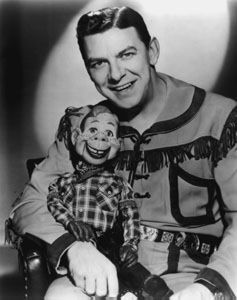“Say kids, what time is it?”
If you’re anywhere in the vicinity of my age group, you know the answer to that question automatically: “It’s Howdy Doody Time!”
Featuring the red-headed, freckle-faced, iconic all-American boy marionette, his human sidekick Buffalo Bill, and a gang of other puppets and people, Howdy Doody was a huge hit on NBC in the 1950’s, even entering the age of color television before sadly going off the air in 1960. The show was set in the fictional small town of Doodyville and featured a live studio audience of young children, called the Peanut Gallery. Each show began with Buffalo Bob asking, “Say kids, what time is it?” and the kids yelling in unison, “It’s Howdy Doody Time!” Then the kids all sang the show’s theme song (to the tune of “Ta-ra-ra Boom-de-ay“).
Even now, when I hear the names of some of the other characters on the show, I can clearly see them in my mind’s eye: the funny expertly-handled marionettes Phineas T. Bluster, Dilly Dally, and Flub-a-dub; the live characters, native Americans Chief Thunderthud (who originated the exclamation “Kawabonga!”) and Princess Summerfall Winterspring of the Tinka Tonka tribe, and of course Clarabell the clown.
Next to Buffalo Bob, Clarabell was probably the most prominent and beloved live performer on the show. Played by actor Bob Keeshan, who later went on to become Captain Kangaroo, Clarabell didn’t speak but communicated via body language, honking horns, and an always ready seltzer bottle that he (she?) didn’t hesitate to use on others. Though I didn’t see the final episode of the show myself, that was the first and only time that Clarabell talked, when he/she sadly and quietly said “Good-bye, kids” at the end of the program. Do any of you remember seeing this episode? How did it make you feel?
You can see many of the elements of the Howdy Doody Show in Sesame Street and other subsequent kids’ shows – the little town (though in a country setting, not an urban one) populated by a diverse and rich mix of unusual, even eccentric puppet and human characters, with the humans interacting with the puppets as if they were real. The Howdy Doody Show also mixed education with entertainment, using some of its skits to teach moral and practical lessons. And, despite the many pranks and pratfalls that made the studio audience shriek with laughter, it had a gentleness and sweetness to it that was replicated in later shows like Mr. Rogers’ Neighborhood.
To see the Howdy Doody Show, check out these DVD’s: The Howdy Doody Show – 40-episode collection , The Best of Howdy Doody – 20 episodes . Say Kids What Time Is It? It’s Howdy Doody Time: The Lost Episodes (2006).
To read about the Howdy Doody Show, try these books: Say Kids! What Time is It? Notes From the Peanut Gallery (Hardcover) , Howdy and Me (Plume) (Paperback) , Howdy Doody: Collector’s Reference and Trivia Guide (Paperback) .


Recent Comments